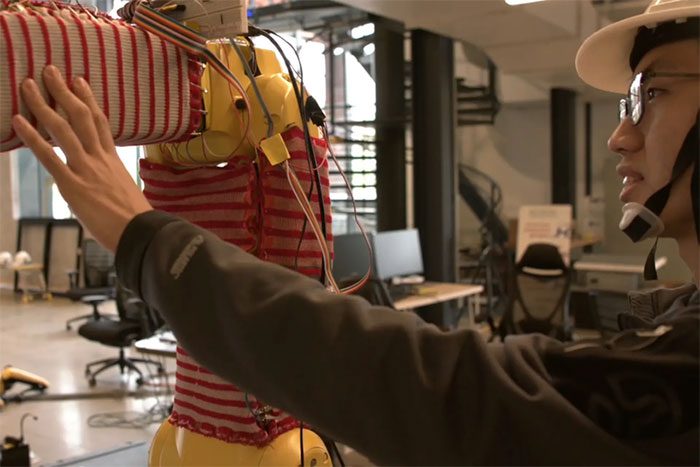To avoid unintentionally harming human colleagues, many industrial robots are equipped with sensors that detect physical contact with people or other objects. Scientists have now invented a high-tech sweater that brings this functionality to robots that previously lacked it.
Named the RobotSweater, this technology is being developed by a team at Carnegie Mellon University in the United States, led by Assistant Professor James McCann and Changliu Liu. The “garment” wraps around a robot’s arm or another device and is connected to a power source. The technology consists of three layers of stacked materials.

This technology also allows humans to train robots to perform certain actions.
The top and bottom layers are made of regular nylon, with evenly spaced stripes of conductive metal fibers running through them. These stripes are arranged in rows on one layer and in columns on the other, forming a grid when viewed from above. Sandwiched between these two layers is a layer of non-conductive insulation mesh.
As long as no external pressure is applied to the RobotSweater, the two layers of conductive stripes remain separated. However, when pressure is applied, some stripes on these layers connect through holes in the mesh layer.
This phenomenon closes a circuit, generating an electrical signal. By analyzing where this signal originates within the conductive stripe grid, one can determine where pressure is being applied to the sweater-wearing robot’s body.
In a real-world scenario, the robot could then respond by stopping its movement immediately. This technology also allows humans to train robots to perform specific actions by touching and guiding them. Additionally, researchers are exploring the possibility of using swipe and pinch commands on the sweater, as if it were a touchscreen.
As an added bonus, since the RobotSweater is made from soft and flexible materials, it can be applied to parts with unusual shapes or where the robot’s movements cannot accommodate standard rigid sensors.
Changliu Liu, an assistant professor of robotics in the Computer Science Department, stated: “We can use that to help robots become smarter during interactions with humans.”
Meanwhile, James McCann, whose research has focused on textile fabrication in recent years, noted: “Knitting machines can shape fibers into non-flat forms, which can be curved or textured. This led us to think that we could create sensors that suit curved robotic limbs.”


















































